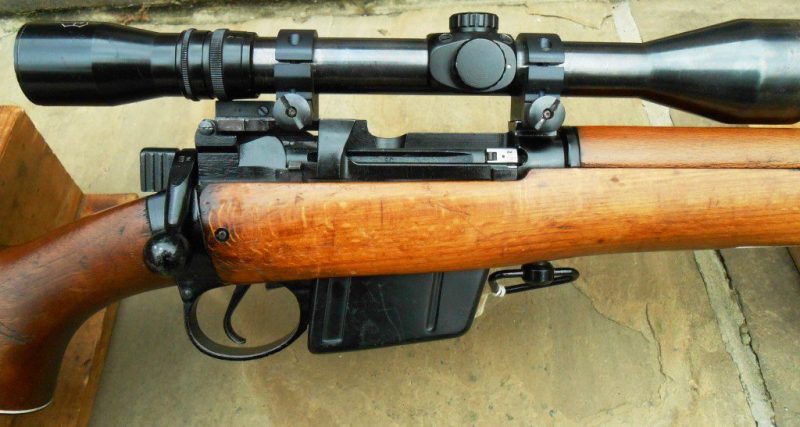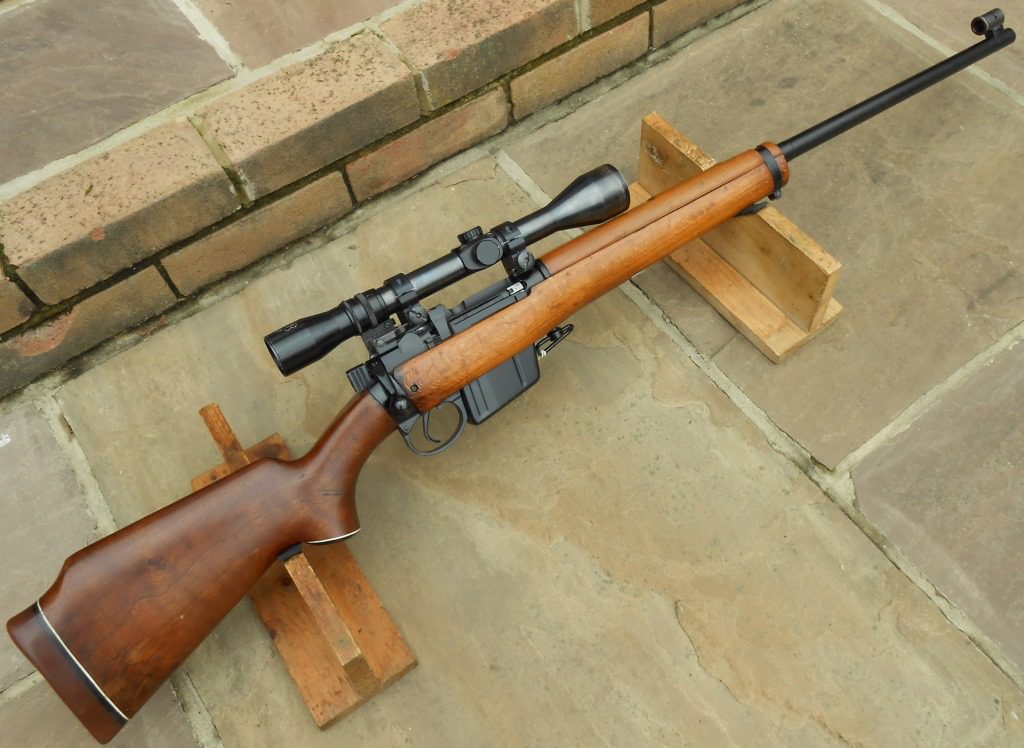Enfield Enforcer was a police sniper rifle chambered in 7.62mm caliber specifically designed for police use. In the early 1970s, the Enfield Enforcer was developed from the military L39A1 target rifle specifically for Police sniper use.
History
In the years following World War Two, the semi-automatic assault rifle emerged as the rifle action of the future. As such, most all development of military bolt action rifles stopped, of course, including the Lee-Enfield. However, popular and traditional thinking persisted on the theory that only bolt actioned rifles could provide the accuracy needed for snipers and marksmen (a thought that remains today).
In addition to this, the military was concerned that the new assault rifles would degrade the individual soldier’s marksmanship principles; in other words, “aimed shots” would be replaced by the “spray and pray” mentality. Another concern early on was for the civilian shooter involved in military marksmanship competitions. What civilian could afford or what government would allow the average person to tote around a privately owned assault rifle?
So on a far smaller scale, development continued with the tried and true Lee-Enfield over the years. This development produced several militaries and civilian target/sniper-type rifles. Namely, on the military side, the L39A and the L42A1, on the civilian side was the Envoy and Excel, and on a Police sideline, the Enfield Enforcer.
The departure from the infantry “line” rifle to that of the specialty rifle allowed the developers to design outside of the box. Only one restriction was placed on them; the rifle must be chambered for the “new” 7.62mm NATO round. The results were; a shortened fore-end (all but the Excel had a top handguard), a free-floated heavy barrel, a modified action to accommodate the 7.62mm round, and the corresponding magazine. Most sported Monte Carlo butts; front tube sights, and rear Parker-Hale competition rear sights.
Design
A bolt action, a single shot rifle chambered for the 7.62 x 51 mm cartridge. The ‘Lee’ bolt is fitted to a cold-forged barrel with ‘Enfield’ rifling of six grooves chordal rifling. The original barrels had standard four groove rifling, and the chordal rifling was introduced to reduce bullet drag and thus give improved long-range ballistics. In practice, it is frequently found that chordal rifling affects short-range accuracy unless the barrel is warm: cold the first two shots go high right and then the remainder of the rounds return to the ‘zero’ pattern.

The magazine is spring-fed, has a 10 round capacity, and is loaded singly. A Charger Guide is fitted, but with a ‘scope’ provided, it cannot be used.
To spotlight the Enfield Enforcer specifically:
Approximately 700 of these rifles were produced in total, not many considering today’s world; a commercial “commemorative” type rifle is usually produced in 1000 rifle numbers. The Enforcer chambered in 7.62mm NATO came standard with:
1) A “Matchmaker” front tube sight,
2) Parker-Hale adjustable twin zero rear competition sight,
3) Free-floated heavy barrel,
4) Shortened (sporter style) fore-end with handguard and Monte Carlo butt,
5) A PICAR 4-10X45 scope mounted on Parker-Hale pads and
6) Upon request of the individual sniper, it could be fitted with a Bi-pod.
All Enfield Enforcer’s were built using new Mk2 actions (trigger hung from the receiver versus turned from the trigger guard), and all were stocked with new beechwood furniture. In keeping with traditional practice, these rifles were issued to individual Police marksmen.
Given today’s liberal thinking, many of these rifles have not survived, being crushed by their former owners, the Police. The attitude of governments today precludes them from surplus firearms for public sale. It is indeed a sad commentary on history that as early as 40 years ago, marksmanship and competitive shooting were a family endeavor.
Sponsored and encouraged by governments. Today it is perceived as a black art, outlawed by some countries and greatly discouraged by others. So if one finds an Enforcer for sale, it should be considered a rare find and promptly bought up. Interesting that the last made Enfields would be the hardest to find.
As a ‘snippet’ of historical interest – In the 1960’s India ordered 60,000 7.62 caliber Rifles from the U.K. Production of the parts commenced, but this was also the time of the India, Pakistan crisis. India wanted to buy Sterling Sub-Machine guns at the same time – when this was refused – India canceled the order for the 60,000 rifles. This is the reason that nearly every 7.62 Magazine you will see is stamped with the 1965 manufacturing date.
Technical specifications
| Manufacturer: | Charnwood Ordnance, United Kingdom |
| Designed: | 1970s |
| Service: | 1970s-1990s |
| Type: | bolt-action repeater |
| Caliber: | 7.62x51mm |
| Barrel: | 699 mm (27.5 in) |
| Weight (empty): | 4.75 kg excluding telescopic sight (10 1/ 2 lb) |
| Effective firing range: | 915 meters (1000 yards) |
| Rate of fire: | single |
| Magazine capacity: | 10-rounds detachable magazine box |
| Sights: |
iron sights; can be mounted with any scope
|
